Raspberry Pi 5 VS Raspberry Pi 4: The Detailed Differences and Comparisons
Prologue
The latest release of the Raspberry Pi 5 has finally made its debut 4 years after the launch of the Raspberry Pi 4, coming with a performance boost and in-house silicon that adds support for PCIe 2.0, all at a starting price of $60. Known for their versatility in a range of endeavors, including robotics and retro gaming, the Raspberry Pi 5 and the old Raspberry 4 have captured attention worldwide. In this article, we will look at the notable improvements and differentiating features of the Raspberry Pi 5 compared to its predecessor, the Raspberry Pi 4.
Raspberry Pi 5 vs Raspberry Pi 4
The Raspberry Pi 5 is the latest addition to the Raspberry Pi family of computers and builds on the huge success of the Raspberry Pi 4. Compared to its predecessor, it features a 2-3x increase in CPU performance, a significant increase in GPU performance, and improvements to the camera, display, and USB interfaces.
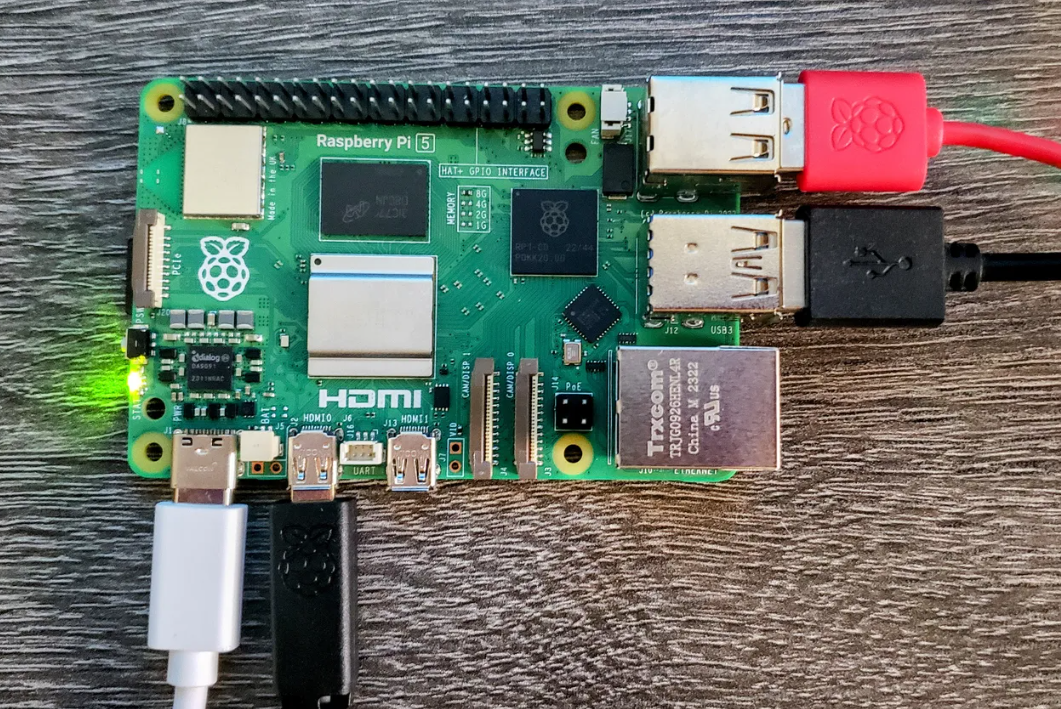
Raspberry Pi 5
These interface improvements are made possible by Raspberry Pi's own RP1 I/O controller chip. This is the first time Raspberry Pi has used the Raspberry Pi chip in its flagship product!
Also by popular demand, two new features have been added to the Raspberry Pi 5 to help track sales (and potential returns) of the product:
1) Each board has a marking on the top of the PCB that identifies the memory density that a particular board is equipped with.
2) All boards have a unique serial number on the board and box for easy tracking.
Raspberry Pi 5 Specifications
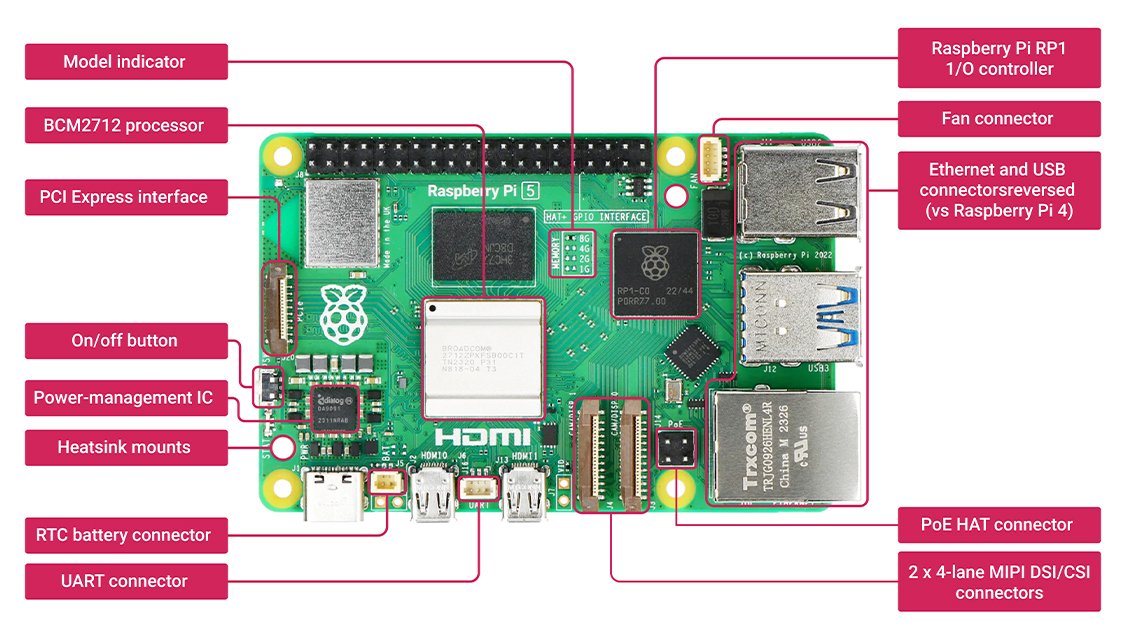
Raspberry Pi 4 Specifications
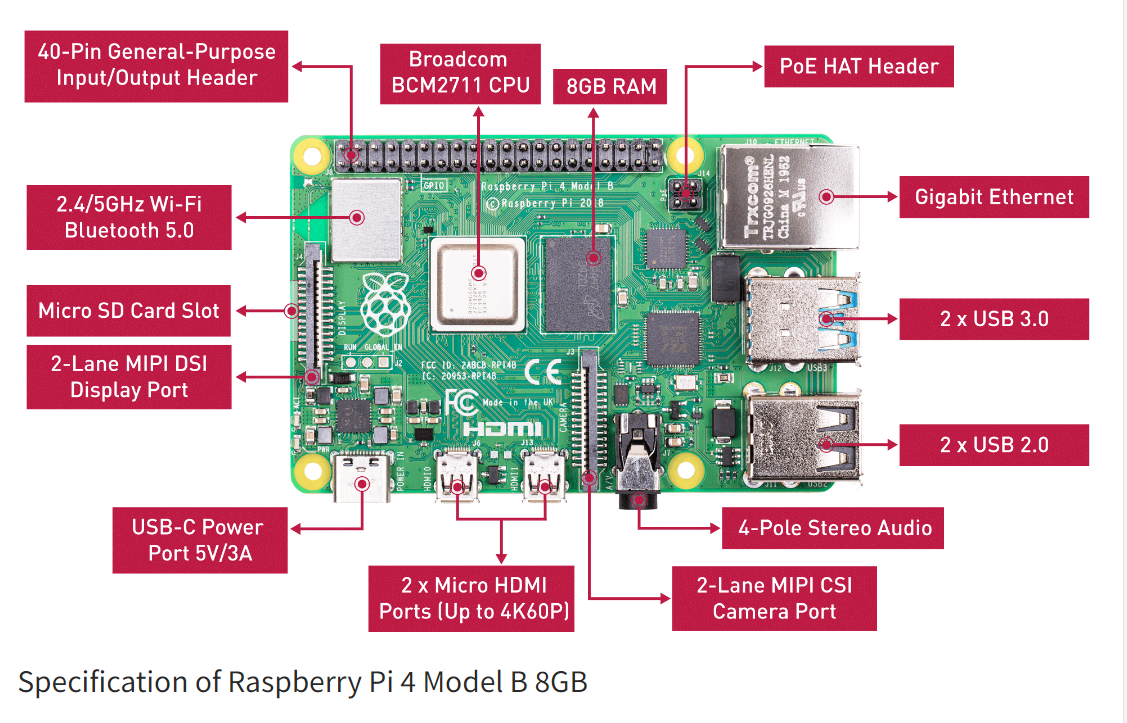
Chip Difference
The latest Raspberry Pi 5 model is equipped with the latest Broadcom BCM2712 chip, which is a significant improvement from the previous Raspberry Pi 4’s BCM2711. The upgraded CPU in the Pi 5 is a quad-core Cortex-A76 processor clocked at 2.4 GHz, which is a noticeable improvement from the Pi 4's quad-core Cortex-A72 operating at 1.8 GHz.
GPU Difference
Moreover, the GPU in the Raspberry Pi 5 has seen some notable improvements, with VideoCore VII at 1.1 GHz replacing VideoCore VI at 800 MHz in the Pi 4.
Display Support Differences
The Raspberry Pi 5 has impressive display support with dual HDMI 2.0 outputs that can both deliver 4k at 60Hz. In contrast, the Pi 4 also offers dual HDMI 2.0, but only one supports 4k at 60Hz while the other is limited to 30Hz.
Raspberry Pi 5, with its advanced device features, supports H.265, which has clear advantages over H.264 in terms of compression efficiency and video quality. In addition, Raspberry Pi 5 is equipped with a 4-channel MIPI interface, which is more suitable for application scenarios with higher data rate requirements, such as high-definition video and high-resolution images, while Raspberry Pi 4 uses the 2-channel interface, which is suitable for some application scenarios with lower resolution or low frame rate requirements.
Memory Differences
The memory configurations of the two vary, with both providing 4GB or 8GB LPDDR4 variants. However, the Raspberry Pi 5 has an advantage with its LPDDR4X-4267 SDRAM, which is faster than the Pi 4's LPDDR4-3200 SDRAM.
More Spec Differences to Know:
Additionally, the Raspberry Pi 5 introduces a single-lane PCIe port for high-performance peripherals, which the Pi 4 does not have. Moreover, the Raspberry Pi 5 has a new onboard power button, just one push to accomplish simple tasks, eliminating the redundant steps to complete them before.
For easy reference, we have provided a side-by-side comparison of the specifications, highlighting the key differences. Those further detailed differences are listed below in the table.
|
|
Raspberry Pi 4B |
Raspberry Pi 5 |
|
CPU |
Broadcom BCM2711, quad-core Cortex-A72 (ARM v8) 64-bit, running at 1.8GHz |
Broadcom BCM2712, quad-core 64-bit Arm Cortex-A76 CPU running at 2.4GHz |
|
GPU |
500MHz VideoCore VI GPU |
800MHz VideoCore VII GPU, supports OpenGL ES 3.1, Vulkan 1.2 |
|
Multimedia |
H.264(AVC) |
H.265(HEVC) |
|
memory |
1GB, 2GB, 4GB, or 8GB LPDDR4-3200 SDRAM (depending on model) |
1GB, 2GB, 4GB, or 8GB LPDDR4X-4267 SDRAM (depending on model) |
|
WIFI |
Dual-band 802.11ac Wi-Fi |
Dual-band 802.11ac Wi-Fi |
|
Bluetooth |
Bluetooth 5.0, BLE |
Bluetooth 5.0 / Bluetooth Low Energy (BLE) |
|
USB |
1 Type-C port, 2 USB 3.0 ports, 2 USB 2.0 ports, 1 Ethernet port, 1 Micro-SD card slot |
1 Type-C port, 2 USB 3.0 ports, 2 USB 2.0 ports, 1 Ethernet port, 1 Micro-SD card slot |
|
Storage |
MicroSD card slot |
MicroSD card slot + PCIE lane for NVME M.2 SSD |
|
Networking |
Dua-Band 802.11acBluetooth 5 / BLEGigabit EthernetPoE via POE + Hat (Incompatible with old version) |
Dua-Band 802.11acBluetooth 5 / BLEGigabit EthernetPoE via POE + Hat (Incompatible with old version) |
|
Power consumption |
Up to 7.5W |
Up to 15W (requires new power supply) |
|
Thermal performance |
Lower temperature and passive cooling option |
Higher temperature and fan requirement |
|
Camera/display ports |
One DSI port for displays and one CSI port for cameras |
Two 4-lane MIPI ports for both cameras and displays (new cables needed) |
|
Audio output |
HDMI, USB, or analog audio jack |
HDMI or USB only |
|
Connector |
2 micro HDMI ports (supports up to 4Kp60), 1 2-lane MIPI DSI display port, 1 2-lane MIPI CSI camera port, 4-pole stereo audio and composite video ports |
2 micro HDMI interfaces (supports up to 4Kp60)compatible with HDR, 2 4-channel MIPI camera/display transceivers, 1 PCle 2.0 interface, 1 battery connector (for real-time clock), 1 UART port |
|
Input power |
5V DC power via USB-C (3A minimum), 5V DC power via GPIO (3A minimum), Powered by PoE (requires separate PoE+HAT) |
Provides 5V/5A DC power through USB-C, supports power supply through GPIO, provides 5V DC power through PoE (requires separate PoE+HAT) |
|
GPIO |
Raspberry Pi standard 40-pin connector |
Raspberry Pi standard 40-pin connector |
Raspberry Pi 5 Datasheet
Raspberry Pi 5 RP1 Peripherals
What Makes Raspberry Pi 5 better than Raspberry Pi 4?
The Raspberry Pi 5 is an impressive upgrade for those who require top-notch performance in their projects. One of the most notable improvements is its CPU and GPU, which are more powerful and efficient compared to the Raspberry Pi 4. The CPU is faster by an additional 600 MHz, providing a significant boost to raw processing capability.
The Raspberry Pi 5 also outshines the Raspberry Pi 4 in graphics performance. Its VideoCore VII architecture is 300 MHz faster than the VideoCore VI found in the Pi 4 and offers several compatibility and efficiency enhancements. Moreover, the Raspberry Pi 5 supports Vulkan 1.2, which is an advantage over the Pi 4's Vulkan 1.0 support, making it a great choice for gamers and visual project enthusiasts.
However, power usage is a point of consideration for the Raspberry Pi 5. While the new processor is more power-efficient, it consumes more power, which means that Raspberry Pi 4 power supplies won't be compatible with the latest Raspberry Pi 5. So, keep this in mind if you're planning to upgrade to the upcoming iteration.
Raspberry Pi 5 vs Raspberry Pi 4: What makes them look different from each other?
When comparing the Raspberry Pi 5 to the Raspberry Pi 4B, what improvements and reductions can be observed in Raspberry Pi 5?
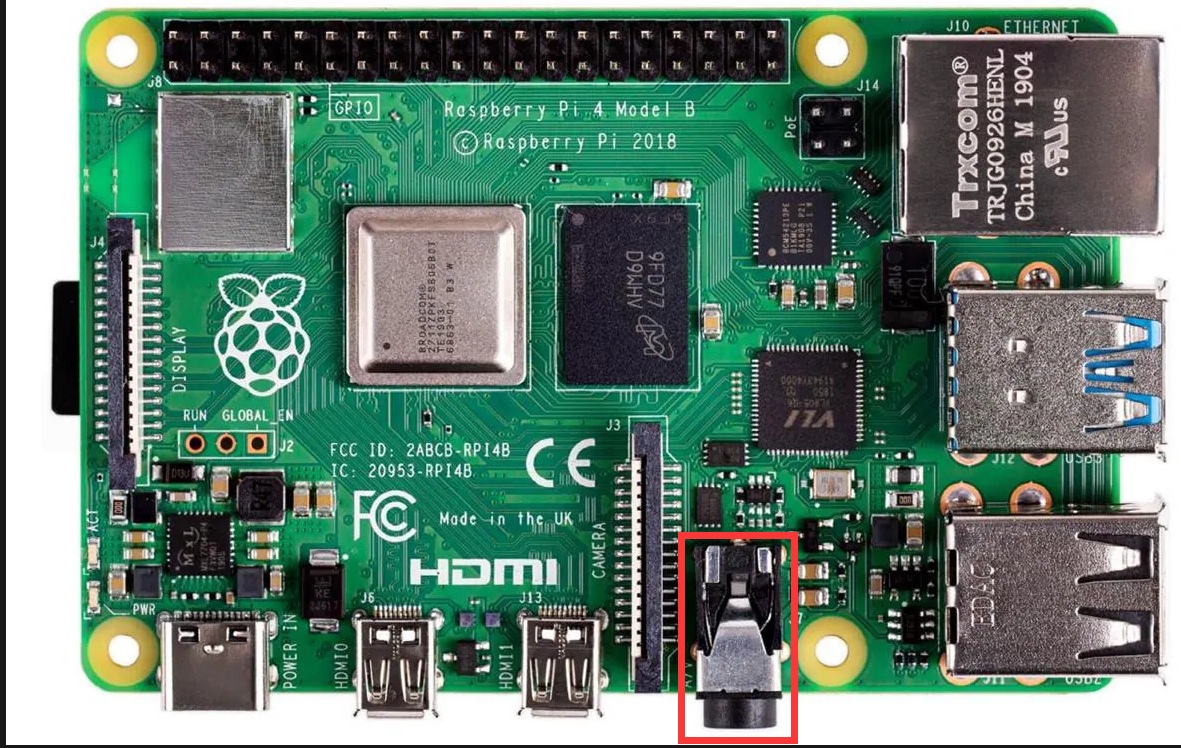
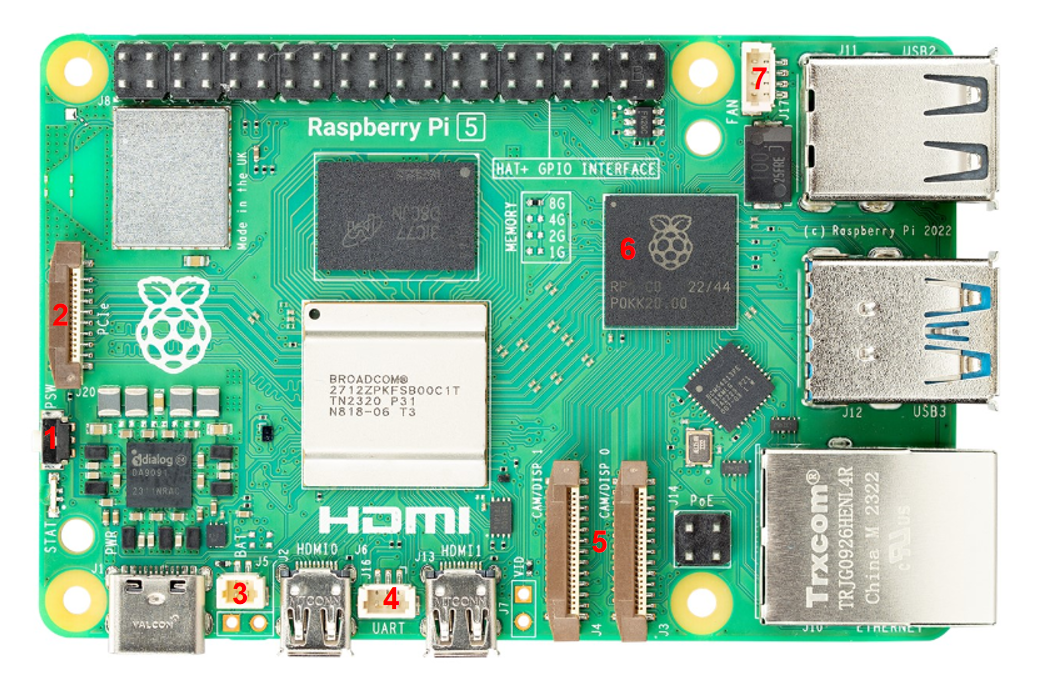
Here is the detailed table illustrating the improvements and reductions Raspberry Pi 5 has when compared with Raspberry Pi 4.
|
Raspberry Pi 5 Improvements |
Raspberry Pi 5 Reductions |
|
1. A power button on the left is added. |
Audio/composite video interface erased |
|
2. A PCIe interface on the left is added. |
|
|
3. A battery connector interface to the bottom is added. |
|
|
4. A UART interface to the bottom is added. |
|
|
5. Two cameras/display transceivers are added to the bottom. |
|
|
6. The RP1-CO chip is added to the top right. |
|
|
7. A fan connection port has been added on the upper right side. |
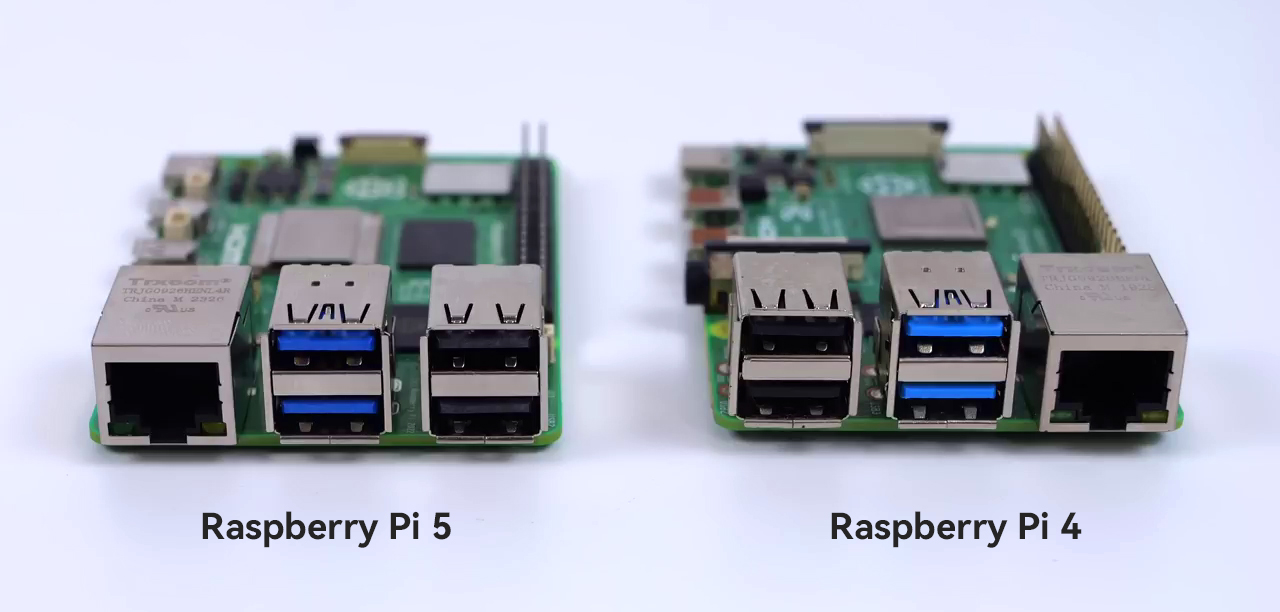
Also, Raspberry Pi 4 and Raspberry Pi 5 have USB 2.0 and Ethernet ports in different locations.
Raspberry Pi 5 vs Raspberry Pi 4 in Price
The latest Raspberry Pi 5 has impressive advancements, which is reflected in its starting price of $60 for the 4GB model. In contrast, the previous Raspberry Pi 4 has a more affordable starting price of $35 for its basic version of 1GB of RAM. However, if we compare models with similar RAM configurations, the price difference decreases. For instance, a 4GB Raspberry Pi 4 is priced at around $55.The cost difference between the two models varies depending on the exact configurations being compared.
Raspberry Pi release history
Based on the various releases the company has had since 2012 when the initial Raspberry Pi was introduced, there hasn't been a consistent pattern in terms of when upgrades are released, unlike in other markets like smartphones and tablets. Typically, Raspberry Pi unveils new upgrades every one to two years.
|
Raspberry Pi model |
Release date |
|
Raspberry Pi 1B |
June 2012 |
|
Raspberry Pi 1B+ |
July 2014 |
|
Raspberry Pi 2B |
February 2015 |
|
Raspberry Pi 3B |
February 2016 |
|
Raspberry Pi 3B+ |
March 2018 |
|
Raspberry Pi 4B |
June 2019 |
|
Raspberry Pi 5B |
October 2023 |
About Raspberry Pi 5 Accessories:
27W USB-C PD Power Supply
The latest 27W USB-C PD (Power Delivery) power supply provides Raspberry Pi 5 with a maximum of 5.1V, 5A, which broadens the range of peripherals that can be powered. By default, the total power drawn from the 4 USB ports on Raspberry Pi 5 is limited to 600mA. However, when the USB-C PD Power Supply is recognized, this limit automatically increases to 1.6A.
Moreover, the USB-C PD Power Supply can provide 3A @ 9V, 2.25A @ 12V, and 1.8A @ 15V to PD-compatible items, making it an excellent and cost-efficient power supply for non-Raspberry Pi applications.
|
Input: |
100-240VAC |
|
Output: |
5A @ 5.1V, 3A @ 9V, 2.25A @ 12V, 1.8A @ 15V |
|
Connector: |
USB-C |
|
Cable: |
1.2m, 18awg |
|
Colors |
White, black (coming soon) |
|
Plug Types: |
US, Canada (type A) |
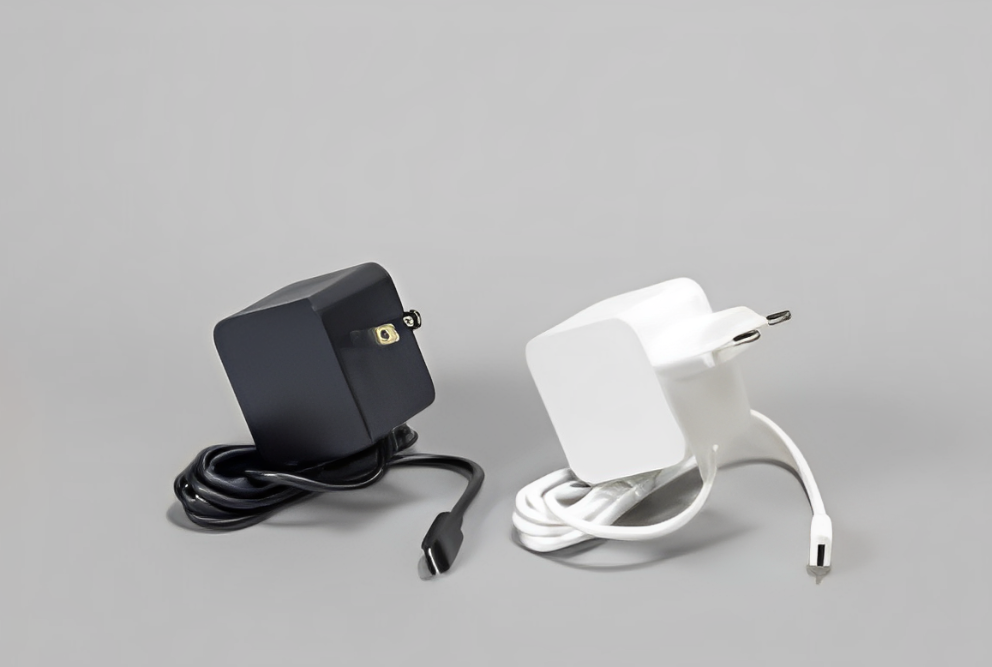
Raspberry Pi 5 Case
The new Raspberry Pi 5 case is an evolution of the Raspberry Pi 4 case with improved cooling to support the higher peak power consumption of the Raspberry Pi 5. It features a variable-speed fan that is powered and controlled by a dedicated connector on the Raspberry Pi 5 PCB.
The case will launch in a classic red/white color theme and will be followed by a black/gray color style.

Raspberry Pi 5 Active Cooler
The Raspberry Pi 5 active cooler is an alternative cooling solution for those who want to use Raspberry Pi 5 under constant heavy load without a case. It combines a large metal heatsink with a variable-speed fan, which is also powered and controlled via the fan connector, and attaches to the Raspberry Pi 5's PCB using a pair of spring-loaded pins in the mounting holes.

The Active Cooler is an anodized aluminum heatsink that comes in a single piece and has a built-in blower. It includes pre-applied thermal pads for heat transfer and is mounted directly onto the Raspberry Pi 5 board using spring-loaded push pins. The Raspberry Pi firmware actively manages it, and the blower's fan turns on when the temperature reaches 60°C. As the temperature rises to 67.5°C, the fan speed increases, and at 75°C, the fan operates at full speed. When the temperature drops below these limits, the blower's fan spins down automatically.
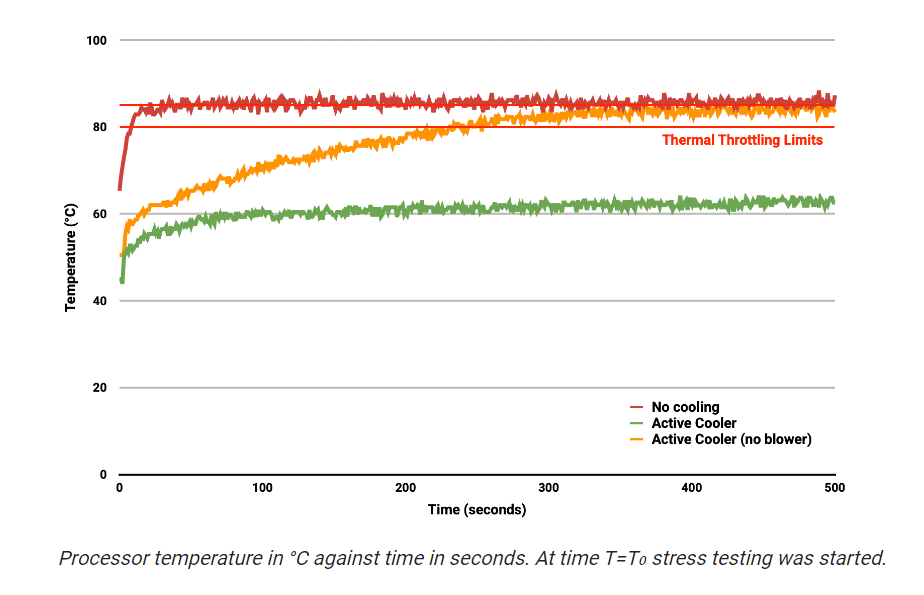
The processor's temperature in °C is plotted against time in seconds, with stress testing starting at time T=T₀. Thanks to the passive heatsink, the Active Cooler helps to maintain a lower idle temperature of approximately 45°C. During prolonged testing under heavy load, the Cooler's fan increases to a low speed, stabilizing the CPU temperature at 60°C, with a maximum temperature of 62 to 63°C observed during the tests.
Raspberry Pi 5 RTC Battery
This rechargeable lithium battery is designed to power Raspberry Pi 5's onboard real-time clock (RTC) when the main power is disconnected.
A Panasonic ML-2020 lithium manganese dioxide battery is included, coming with a two-pin connector suitable for connecting to the battery connector on the Raspberry Pi 5 PCB and double-sided adhesive pads for mounting to the inside of the case or other convenient location.
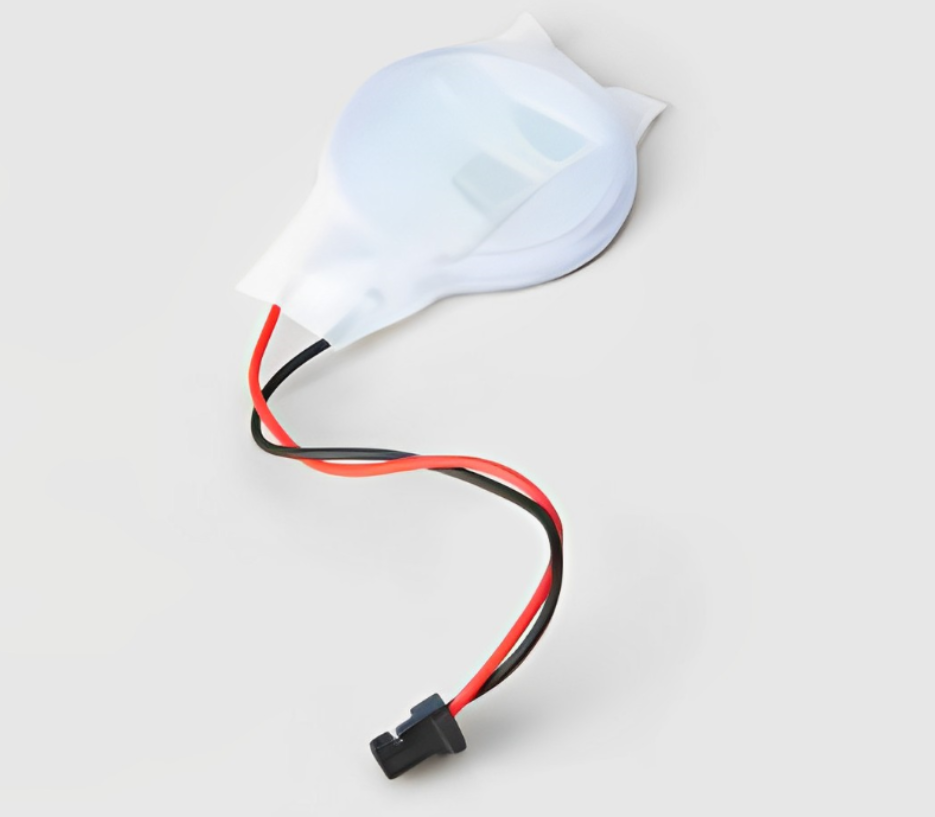
Camera and Monitor Adapter Cables
Raspberry Pi 5 comes with two 4-lane MIPI connectors, each of which can support a camera or display. These connectors utilize the 22-way, 0.5mm-pitch "mini" FPC format, which is identical to the Compute Module Development Kit's format. To connect to the current camera and display products' 15-way, 1mm-pitch "standard" format connectors, adapter cables are required.
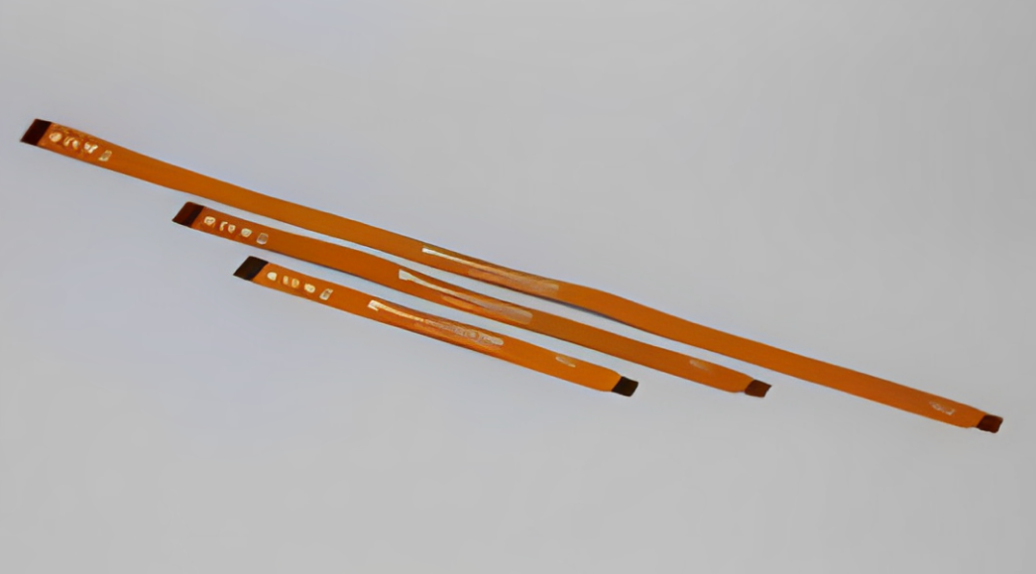
In the future Elecrow will provide mini to standard adapter cables in varying lengths of 200mm, 300mm, and 500mm. It's important to note that camera cables are not compatible with monitors and vice versa.
Please keep in mind that the camera cable should not be used with a display, and vice versa. The Raspberry Pi brand cameras and displays will still be equipped with the old-style cable until further notice.
Accessories - Raspberry Pi 5 Desktop Kit
This is the latest version of the Desktop Kit and here is what it contains.
- Raspberry Pi 5 case
- 27W USB-C PD power supply
- Raspberry Pi keyboard
- One mouse
- 32GB SD card with Raspberry OS Bookworm
- Two original micro HDMI cables
- The fifth edition of the Raspberry Pi Getting Started Guide
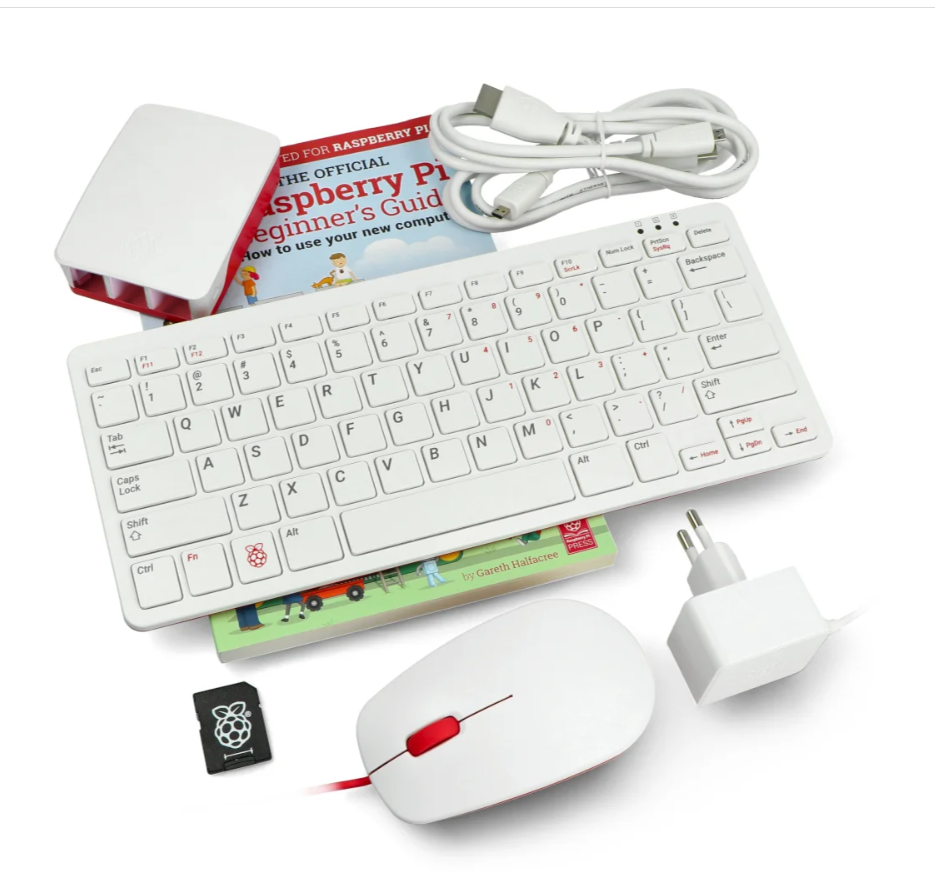
As before, the Raspberry Pi 5 motherboard itself is not included: you will need to add a 4GB or 8GB board before the kit ships.










